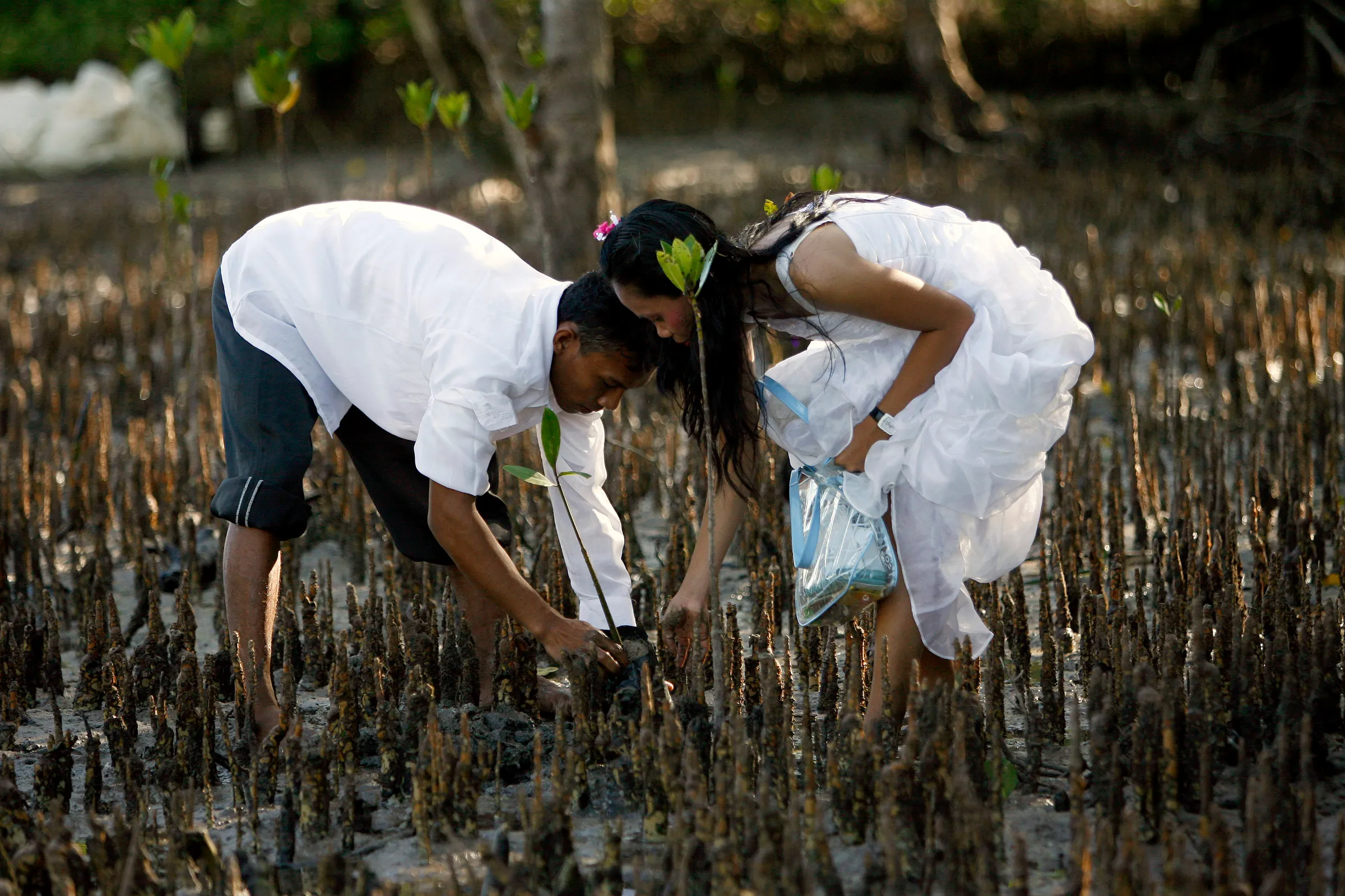Philippines uses mangrove buffer zones to protect its coastlines

A couple plants a mangrove tree in San Jose town, Palawan province, western Philippines, February 14, 2010. REUTERS/Romeo Ranoco
What’s the context?
Renewing mangroves and beach forests could protect Philippines coast from typhoons, storms, floods and land erosion.
MANILA - Often battered by typhoons and floods, protecting the coastline is a priority for the sugar-producing Philippines province of Negros Occidental.
But instead of man-made defences, local leaders have turned to reviving natural barriers with 100-metre-wide strips of vegetation, including coastal mangroves and beach forest species to counter erosion and protect from storms.
Negros Occidental began setting up its "coastal greenbelt" network in 2022, the first of its kind in the Philippines.
It led to the establishment and protection of more than 1,000 hectares of mangroves, beach forests and wetlands across Negros Occidental, which now serve as living buffers against typhoons, coastal erosion and saltwater intrusion, directly contributing to the province's disaster risk reduction strategy.
The Negros Occidental coastal greenbelt could become a model for the country's thousands of miles of coastline, which are threatened by climate change, urban expansion and deforestation.
"Local government units are already aware of the benefits of coastal greenbelts in terms of saving lives and properties from destruction," Gloria Estenzo Ramos, vice president of ocean conservation group Oceana Philippines.
More than 90 local government units have since passed their own policies or ordinances designating parts of their areas as greenbelt zones, according to her organisation.
Negros Occidental is also home to the 89,000-hectare Negros Occidental Coastal Wetlands Conservation Area, which hosts several endangered species, such as turtles and dolphins, and was declared as wetland of international importance in 2016.
A 100-metre strip of mangrove can reduce the energy of waves, by up to 66%, a 2012 study by British scientists said.
With 60% of Filipinos living in coastal areas and vulnerable to climate disasters, wetland experts are now pushing for a similar measure nationwide and lawmakers have introduced legislation to establish national coastal greenbelt zones.
The Philippines House of Representatives unanimously passed a coastal management bill in 2023 that would require coastal towns and municipalities across the country to create 100-m greenbelt zones similar to Negros Occidental.
But the bill is still waiting approval by the Senate as it has not been considered a priority for debate.

Rescuers assist residents on a boat along a flooded road following heavy rains brought by Typhoon Gaemi, in Marikina City, Metro Manila, Philippines, July 24, 2024. REUTERS/Lisa Marie David
Rescuers assist residents on a boat along a flooded road following heavy rains brought by Typhoon Gaemi, in Marikina City, Metro Manila, Philippines, July 24, 2024. REUTERS/Lisa Marie David
Threats to coastal ecosystems
Millions of Filipinos benefit from coastal ecosystems like mangroves, seagrasses, mud flats and corals in both rural and urban communities, according to Wetlands International Philippines.
But these coastal protections have suffered for decades.
By the 1990s, Philippines had already lost nearly half of its 450,000 hectares of mangroves. Kisha Muaña, policy and advocacy offer of Wetlands International Philippines, said mangroves had been cut down due to "destructive projects along the coasts like reclamation".
Muaña said the bill would help the government monitor where the current greenbelts are and identify areas it could restore.
"There are areas in the Philippines where the stretch of mangroves from the coast to open waters do not reach the 100-metre requirement to block wave energy, so the law can compel territories to supplement them with beach forests," she said.
Julie Ann Bedrio, the provincial environmental officer of Negros Occidental, said proposed developments in coastal areas such as land reclamation and wind power projects had a bigger impact than individuals cutting back vegetation.
"Cutting mangroves wasn't really our biggest concern, but the conversion of mangrove areas to fishponds and infrastructure that are being proposed in the mangrove areas without proper planning," Bedrio told Context.
Aside from development projects, Bedrio said coastlines had also suffered from weak enforcement of coastal laws and pollution from marine litter, including plastics that wrap around mangrove stems and trunks.
Bedrio said establishing a network of greenbelt zones in Negros Occidental also helped encourage dialogue among local leaders, NGOs and environmental experts to monitor, and block if needed, projects that could harm the coastal environment.
First line of defence
As early as 2007, the International Union for Conservation of Nature, a conservation group, recognised the importance of greenbelts as a natural solution for some coastal problems, including sea and wind erosion.
In disaster-prone Philippines, the proposed national policy would mandate the designation of coastal greenbelts based on vulnerability to storm surges, tsunamis and other threats, as well as creating a plan to protect coastal biodiversity.
As the Senate sessions resume in June, Oceana's Ramos said she was confident the bill would be passed soon, with Oceana invited to the technical working group that would look at the current version of the bill.
With local governments using their own limited funding to implement coastal greenbelt policies, Bedrio said it would help them sustain the initiative if the national government supported them with funding or technical assistance.
Still haunted by the thousands killed by the 2013 super typhoon Yolanda, or Haiyan, the environmental officer hopes coastal greenbelts will become a priority for legislators.
"We don't want another Yolanda to happen again and waste lives of Filipinos living in coastal communities because we failed to protect them by putting up greenbelt zones," said Bedrio.
(Reporting by Mariejo Ramos; Editing by Jon Hemming)
Context is powered by the Thomson Reuters Foundation Newsroom.
Our Standards: Thomson Reuters Trust Principles
Tags
- Extreme weather
- Adaptation
- Loss and damage
- Forests
- Biodiversity
- Climate solutions

















